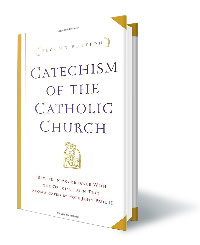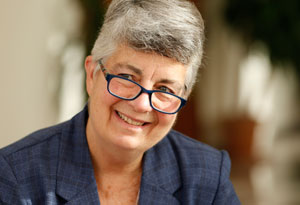 VATICAN CITY — As the Church marks the 25th anniversary of the publication of the Catechism of the Catholic Church, promoting it as a means of teaching the truth about faith remains a challenge and a priority.
VATICAN CITY — As the Church marks the 25th anniversary of the publication of the Catechism of the Catholic Church, promoting it as a means of teaching the truth about faith remains a challenge and a priority.
Since its publication in 1992, the catechism has been translated into 50 languages, including Swahili, Japanese and Gaelic, and it is also available in Braille, video and digital editions.
Nevertheless, in today’s digital age, when people have limitless access to information with the click of a mouse or the swipe of an app, opinions and even “fake news” can either inform or misinform Catholics on the principles of the Catholic faith.
“Society is changing in a very massive way, and it’s much more difficult to reach people,” especially in the digital age, Katharina Karl, professor of pastoral theology and religious education at the Philosophical-Theological University in Muenster, Germany, said.
This ongoing challenge was what prompted the Catholic Church a quarter of a century ago to create a go-to reference that synthesized Church teaching and serve as a guide for the faithful.
The idea of a compendium of Catholic doctrine was one of the fruits of the 1985 Synod of Bishops marking the 20th anniversary of the conclusion of the Second Vatican Council.
After requests from participants for a point of reference “for the catechisms or compendiums that are prepared in various regions,” St. John Paul II accepted their proposal, “considering it as fully responding to a real need, both of the universal Church and of the particular churches.”
“The presentation of doctrine must be biblical and liturgical. It must be sound doctrine suited to the present life of Christians,” St. John Paul wrote in his Apostolic Constitution “Fidei Depositum” (“The Deposit of Faith”) Oct. 11, 1992.
Entrusting this task to 12 cardinals and bishops, the pope chose Cardinal Joseph Ratzinger, the future Pope Benedict XVI, to lead the commission responsible for the drafting of the catechism.
While the need for a text that clearly explained the Church’s teachings was welcomed, some criticized it for being too static or dogmatic and not in line with the spirit of the Second Vatican Council.
“It was said that the catechism failed to take into account the theological developments of the last century, particularly exegetical developments; it was not ecumenical; it was not dialogical” as it made affirmations as established beyond dispute, Cardinal Ratzinger said Oct. 9, 2002, during an address commemorating the catechism’s 10th anniversary.
The future Pope Benedict responded to those opinions by seeking to explain “what a catechism is and what is its specific literary genre,” as well as its proper purpose and doctrinal relevance.
The catechism is “a proclamation of faith,” of witness, for the teaching of the faith, he said. It presents a “given that precedes us,” but whose doctrinal formulation develops in the church, he said.
After his papal election, Pope Benedict continued to urge Catholics to use the Catechism of the Catholic Church as a handbook to rediscover the truths of faith and a deeper knowledge of church teaching.
“Read the Catechism of the Catholic Church and rediscover the beauty of being Christian, of being Church, of living as part of the great ‘we’ that Jesus formed around Him to evangelize the world,” Pope Benedict said in 2012.
In his speech marking the 25th anniversary of the Catechism of the Catholic Church Oct. 11, Pope Francis said the catechism is not only an important tool for believers to understand the faith, but also provides concrete answers to new challenges.
Just as the challenges people face evolve, so does the Christian response since “the word of God cannot be preserved in mothballs as if it were an old blanket to protect against insects,” he said. In fact, “the word of God is a dynamic reality that is always living, that progresses and grows, because it is stretched toward a fulfillment that men and women cannot stop,” Pope Francis said.
Austrian Cardinal Christoph Schonborn of Vienna, who served with then-Cardinal Ratzinger as co-editor of the catechism, told Vatican Radio Oct. 12 that while the development of Church teaching evolves over time, the Church and the Gospel don’t change.
“We must change. This catechism is only 25 years old. The previous one – the Council of Trent – lasted 400 years. Therefore, I hope this catechism is at the beginning of its work for the Church,” Cardinal Schonborn said.
Despite the catechism’s accessibility and continuing development, “there is still a lot to do,” Karl said.
In her Oct. 11 talk, Karl emphasized the need for Catholics to have a formed conscience – rooted in the teachings of the catechism -– that will allow for a “dialogue with God.”
“The catechesis today needs to create a space for people to enter into dialogue with themselves in the first place. It’s something they need to be taught in such a way that in the end it may become a dialogue with God,” she said.
— Junno Arocho Esteves, Catholic News Service
 Pictured: This is a publicity image for the “Religious Signs for Families” app to help deaf children and their family members learn prayers in American Sign Language. The app is an initiative of the Office for Persons with Disabilities and the Deaf Apostolate at the Archdiocese of Philadelphia. It will be available in early November in Apple’s App Store and Google Play. (CNS | Deaf Apostolate of Archdiocese of Philadelphia)VATICAN CITY — When Sister Kathleen Schipani found out she was usually the very first person to teach deaf children to pray, she decided there had to be an app to fix that.
Pictured: This is a publicity image for the “Religious Signs for Families” app to help deaf children and their family members learn prayers in American Sign Language. The app is an initiative of the Office for Persons with Disabilities and the Deaf Apostolate at the Archdiocese of Philadelphia. It will be available in early November in Apple’s App Store and Google Play. (CNS | Deaf Apostolate of Archdiocese of Philadelphia)VATICAN CITY — When Sister Kathleen Schipani found out she was usually the very first person to teach deaf children to pray, she decided there had to be an app to fix that.
Learning to pray usually happens in the family, when a parent or relative recites the words for grace before meals, asks for blessings or requests guidance or protection, the Sister of the Immaculate Heart of Mary told Catholic News Service in Rome.
But when a child is born deaf into a hearing family, those kids shouldn’t have to miss out on learning Catholic prayers or religious terms as they learn American Sign Language, she said Oct. 20.
Sister Schipani, who is director of the office for persons with disabilities and the deaf apostolate at the Archdiocese of Philadelphia, was in Rome as part of a conference sponsored by the Pontifical Council for Promoting New Evangelization. The gathering Oct. 20-22 was dedicated to sharing best practices in engaging and catechizing persons living with disabilities.
Lots of apps exist for learning ASL, she said, but there is nothing dedicated to religious terms, daily devotions or prayers of blessing, love, thanks and praise. The app meant to fill that gap is called, “Religious Signs for Families,” and was to be available from the iTunes App Store and Google Play in early November.
“The locus of learning your faith starts in the family, so this app is really to provide families with the ability” to foster prayer in the home and bond with each other and with God as they pray in ASL, she said. It also will help teachers who want to teach elementary school students how to pray using sign language.
“Deaf people have deep experiences of prayer,” she said, particularly because it involves praying with “their whole body” with signing and visualization.
“Deaf people have never heard the language that we speak so they are not hearing the little voice in their head like we are,” she said. Instead some people say they pray visually with beautiful imagery or with seeing hands signing in their head.
While sacred music does not have the same ability to draw deaf individuals to prayer, sacred or beautiful art does, she said.
 “A lot of deaf people have not been catechized because there was no one to sign to them, and that really is what the sad thing is – when there is no opportunity for deaf people to know religious language and have an experience of someone teaching them,” she said.
“A lot of deaf people have not been catechized because there was no one to sign to them, and that really is what the sad thing is – when there is no opportunity for deaf people to know religious language and have an experience of someone teaching them,” she said.
Sister Schipani said the beautiful thing about sign language is the signs are often “iconic,” reflecting what the thing is and, therefore, they can convey the theology behind the concept.
For example, she said, the sign for “heaven” in the Jewish faith is moving both hands in a way that suggests a semi-circular dome – the heavens – overhead.
In the Christian faith, she said, the sign conveys the canopy of heaven, but with the other hand going through and up, “because we believe that Jesus, our savior, has come and we’re saved so we can have the possibility of entering heaven.”
The app has captions and voiceover in English and Spanish. More information can be found at www.deafcatholicphilly.org/religious-sign-app.
— Carol Glatz, Catholic News Service

